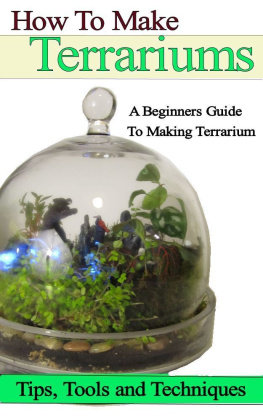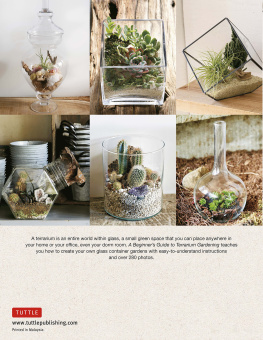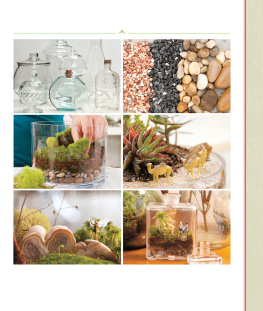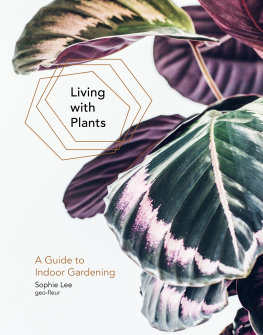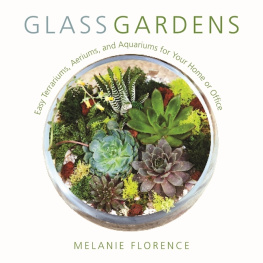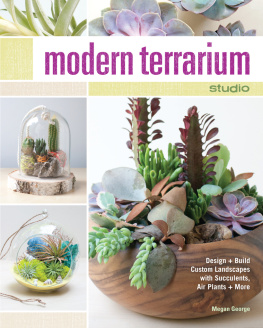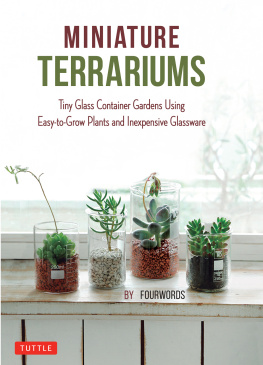How to Make Terrariums
The easy guide to making beautiful terrariums Including Pictures and four terrarium projects
Will Kalif
Copyright 2016 by Will Kalif. All Right Reserved.
No part of this publication may be reproduced, distributed, or transmitted in any form or by any means, including photocopying, recording, or other electronic or mechanical methods, or by any information storage and retrieval system without the prior written permission of the publisher, except in the case of very brief quotations embodied in critical reviews and certain other noncommercial uses permitted by copyright law.
This book is part of the storm the castle series of books. Lots more tutorials on terrariums, including videos, on my website here:
http://www.stormthecastle.com/terrarium/index.htm
A Thank you from Will

First off I want to say thank you for buying this e-book. I hope you enjoy it and I hope it helps in your pursuit of making beautiful little terrariums. And I want to say thank you for visiting my website ( StormTheCastle.com ). Its great to have you as a web visitor. And, if you have any suggestions on how to make my website or this e-book better I would love to hear about it!
And, if you take any pictures of your terrarium be sure to email them to me! I would love to put the pic or pictures on my website so other people can enjoy your terrarium too.
Want to see pictures of other peoples terrariums? I have hundreds of them right here:
Pictures of Terrariums on my website
I have been making terrariums for years and it is my pleasure to share what I have learned with you! Have fun!
Table of Contents
Table of Contents
Who This Book is for
This book is for adults, teens and children who want to make a terrarium. It covers all the basics of what a terrarium is, how they are made and most importantly how they work. Even if you don't have a green thumb you can have a successful terrarium. This book shows you how. And it is done by example. We actually make terrariums in the book .
Introduction
A terrarium is an amazing thing. It is a miniature eco-system all unto itself, able to sustain itself for long periods of time with very little care. Just a moderate amount of sunlight is all it will need as long as you make it right and follow some simple rules. I will show you how to successfully make a nice terrarium that should give you a lot of satisfaction and a bit of fun.
About Terrariums
Technically a terrarium is a self-contained and closed system. It is in a container that is 100% closed. This is the truest form of the terrarium. And it is important because it forms a self-sustaining eco-system. But terrariums really take a whole lot of different forms and nowadays a collection of plants in some kind of container could also be considered a form of terrarium. And, these containers sometimes also have small creatures like turtles, frogs, or lizards. They are often called terrariums and this is ok but they are really vivariums. This is because when it has some kind of a critter in it the health and well being of the small animal comes first. The plants become secondary.
Open or Closed?
The truest form of terrarium is that of a completed closed system, a bottle, jar, box or container that is sealed. This gives us a true miniature eco-system. And a lot of this e-book covers that very subject. But, I have relaxed those rules a little bit and we will cover open container terrariums. The only real stipulation with that is that it is some kind of a container just not completely closed.
In this e-book I will take you through a wide variety of terrariums, tell you how to make them, give you some good rules of thumb on planting, and on selecting the plants. I also show you the basics of the container which is pretty important and makes a big difference in how your terrarium looks and acts.
We will actually build for different terrariums and of both types closed and open.
A Brief History of the Terrarium
Where did it all start?

Nathaniel Bagshaw Ward is the man who first discovered the terrarium. He was an amateur botanist who lived in London in the early 19th century. He published a book in 1842 entitled On the Growth of Plants in Closely Glazed Cases. And in the book he describes his discovery. I will summarize it a bit for you here.
Being an amateur botanist he was very interested in plants of course and one of his dreams was to have a big wall with Ivy, ferns, and moss growing on it. So, he built the wall and tried growing these plants on it. But they kept dying. He couldnt keep them alive because London at that time was a manufacturing center and, as he describes it, the factories poured large amounts of soot on the city.
This sooty and polluted environment wasnt conducive to the growth and health of his plants.
He was doing another experiment, in the summer of 1829 where he buried a chrysalis in some mould (soil) in a closed jar. He observed that as the day got warm moisture formed on the glass of the container, collected then returned to the mould (soil) in a daily cycle. Before the chrysalis made its transformation he saw that a seedling fern and a grass sprouted in the container.
The container, he theorized, had all the conditions needed for their growth. And one important thing that his backyard didnt have it was free of soot!
He brought the container in his house and placed it on a window. The plants inside lasted for four years. And would have lasted longer if the lid hadnt rusted and allowed rainwater inside.
This set him off on a variety of experiments with different kinds of plants in glass containers.
The whole art of this took Victorian England by storm and people began keeping plants in containers in their house.
But, the art of the terrarium also had a big impact on shipping. These container s were brought onto ships where they were used to protect delicate plants during long ship journeys from exotic locations. One of the biggest things was that the containers protected plants from the corrosive and damaging sea salt air much as Wards plants were protected from the soot filled air of London.
They were placed in tight glass boxes with a couple of rules. Let sunlight in, preserve the humidity and keep the salt air out!
It causes a boom in the shipping of exotic plants like Tea and Breadfruit!
How a Terrarium Works?

The terrarium, as we said, is a miniature eco-system. This is a fascinating thing and it works because of a pretty simple process of water flow. The graphic here shows this water flow.
Sunlight causes the water inside the container to evaporate and accumulate on the sides and top of the glass covering. As it accumulates it flows back down the sides into the soil. This process is repeated indefinitely.
So we have a nice flow of water through the system.
We help this process a little bit by the way we build the terrarium. For example we have the glass or clear plastic which allows the sunlight in but doesnt allow the moisture out. And we have a layer of pebbles on the bottom of the container. This causes a reservoir to hold the water without waterlogging the soil.
We can also purify this water as it flows by adding a layer of activated charcoal. The water flows through the charcoal and the impurities are captured.
And you can take a little optional step. There is a thin layer of sphagnum or Spanish moss between the stones and the soil. This layer prevents the soil from falling down between the stones and causing a muddy mess. It is optional but still a good idea to do.
Next page
